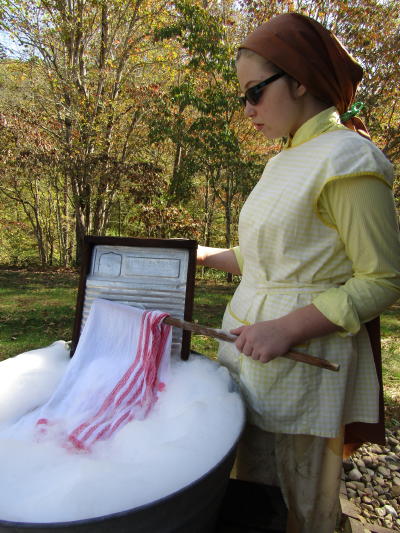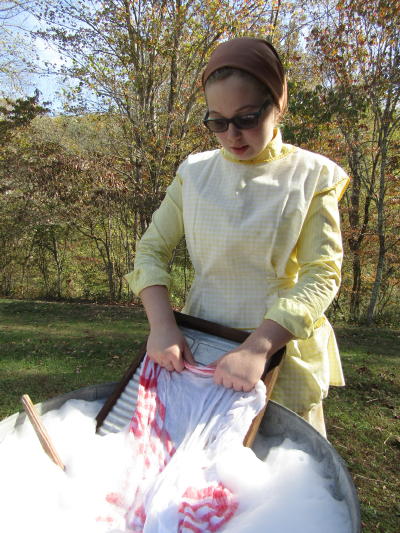WORSHIN' CLOTHES THREE DAY EVENT IN OLD DAYS - Boilin', Stirrin', Lyein', Starchin' And Ironin', Coming Of Engine Driven Washer

Ava Nichols of Richardson simulates the laborious work
of washing clothes in the early part of 20th Century
By Myrtle Gertrude McCoy Weaver 1982
(This story was written at the time of the death of her beloved sister Thelma McCoy Roach in 1982)
Water was scarce on the hill at the McCoy Homestead at Hur, and on Monday morning we would begin the "wash day" from Spring to Autumn by carrying or dragging the dirty clothes in meal sacks down the steep hill behind the house.
There was a creek and a spring to produce the water, building a wood fire to heat the water in a large kettle. The first wash in soapy heated water to be stirred by a wooden stick or scrubbed on a washboard, then placed in a kettle of rinse water and then starch water. Most everything was starched.
Just doing the three licks took much of the day.
My sister Thelma and I were about 10 years old, and were seasoned washers with our mother, Bessie was too young to participate.
Washing was women's work, our six brothers were doing other things.
The clothes got boiled in homemade soap, soap my mother made from lye, ashes and grease from the fat of butchered hogs. Lord, the soap was hard on the hands, making them shrivel.
Thelma and I were the starch makers, returning to the house to whip up a batch, carrying it back down to the creek with some lunch for the others.

Ava demonstrates washboard scrubbin'
It took us from early in the morn 'til late evening, and sometimes we'd go back the next day to finish.
On most wash days, Thelma would go back to the house and get our horse Fred, and we'd get more long sacks sewn together in which to put a "ton" of wet clothes and stand on wash tubs to place the wet clothes on the back of Fred to hang on the lines beside the house.
We had no clothes baskets.
During a later season, it occurred that we should put up some lines for drying down at the wash hole.
Most everything was starched and ironed. A number of irons were placed on a wood burning stove to heat, and a bottle of water with a shaker was used to dampen the clothes on the ironing board to get the final smooth (sometimes stiff) texture.
Ironing was laborious, from sheets and pillowcases to dresses, pants and handkerchiefs.
Many times my mom would iron after everyone was in bed until midnight with the three old irons, sometimes using beeswax on them to make them iron smoothly.
During the winter months the washing took place in the basement, mostly using water from rain barrels.
It would not be a stretch to say that washing clothes for our dad and mom, our nine siblings and a number of house guests, would take nearly three days of labor.
Then came the gasoline driven washing machines and life was good.
THE COMING OF THE MAYTAG ENGINE DRIVEN WASHER
In 1927, a Maytag clothes washer came with a gas engine. That bit of automotive engineering-turned-home chore helper may seem strange today.
Former Calhoun native Paul Mollohan, after reading the above story, was reminded that his dad, Ernest Mollohan, sold the engine driven wash machines door-to-door in Calhoun.
"He was a young man who sold them off the back of a flatbed truck in the late 20's and early 30's. He would travel all around the five county area."
"I remember when I worked for the State Road Commission in Calhoun County on the road patching crew in the Summer when I was in high school. We were working down on Barnes Run. Lew Ferrell and Jake Kirby sent me up the road to get water for our cooler and I stopped at this house and introduced myself and asked the lady if I could have some water for the crew. She looked at me for a second and said, "Are you Ernie Mollohan's boy?"
"I told her that I was and she then told me the story about her Maytag washing machine. She said my Dad stopped by one day and wanted to sell a Maytag washer."
"She told him that they didn't have the money. He said that could keep it for a month or so and he would stop by and take it back if they didn't want it."
"She said that he did come by about a month later. She also told me that there was no way was he taking the washer. They bought it. I believe it was the Hughes family."
"I still remember people bringing Maytag wringer washing machines back to the Super Service for repair 30 years later. Their loud, loud sound and fumes were boggling," concluded Mollohan.
The first automatic washer wasn't available until 1937.